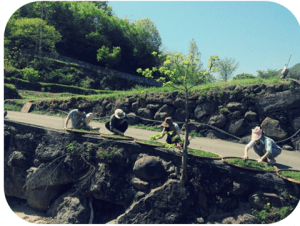Using Personal stories as pedagogical resources
What do you do when you’ve been using the same grammar practice activities, worksheets, funny pictures, and PowerPoint games for a long time and things feel stale and unsatisfying? One of the best answers to this I have ever heard came from the legendary philosopher, Louis CK: When you’ve used up all the basic ideas, ‘you can only dig deeper’ (caution to link followers: abundant cursing [plus hilarity] in the video). What can that mean for teachers? Just as in the comedian’s case, I believe it can mean putting more of ourselves into our teaching, and one way to do this is to talk about things that we have really experienced and to share our stories.

Louis CK: “When you’re done telling jokes about airplanes and dogs… you can only dig deeper.’
The most meaningful language practice
We know from narrative theorists like the late, great Jerome Bruner (2004) that people understand and recount their real lives as narratives; storytelling is universal to humankind. Therefore, by encouraging students to practice English through personal storytelling, we can be confident that their language use satisfies the all-important criteria of meaningfulness and relevance (Yang & Gamble, 2013). What’s more, being asked to share one’s story can be a rare and enjoyable experience (Ellis, 2016), so students may be motivated to use English to tell their own stories in contrast to other, more abstracted and decontextualized activities. This much I believe, many would agree on. However, I’d like to go further and propose that teachers can/should bring their own stories into the classroom, also.
Confessing of ourselves, humanizing teaching
There are several reasons for suggesting this. One reason is quite straightforward: if I want my students to share their stories as part of their language practice, so should I share. Bell Hooks (1994) argues that teachers shouldn’t expect students to do things that the teachers themselves will not, and so by sharing my own stories I can set the example I would like them to follow. She (Hooks) also talks about the importance of ‘confession’ in class (ibid). By talking about ourselves with honesty we lay the foundations needed to connect and build trust with our students, get closer, and make the classroom a warmer and more open environment. What more could we want as teachers of communication?
For me, this warmness extends beyond the classroom. Oftentimes, when I sit down at home to prepare a lesson plan or materials, I feel a sort of coldness as I consider certain of my options. How to present the meaning of a grammar form? With abstracted, personally meaningless examples? Here’s a picture of a man posing for a stock photo in which he is eating an ice-cream. Example sentence: ‘He used to eat ice-cream’. I can only speak for myself, but having been on the job a few years, I can’t get enthusiastic about that using that sort of method like I did way back in the beginning. However, the warmth I so need to feel in my work as a teacher comes flooding back when I consider, instead, how to use examples of the grammar that are true for me. ‘I used to live in Japan’. Now there’s a sentence with some potential.
Telling your stories – the joy of old photos
Recently in my teaching, I’ve been making use of my old photos. This is a new use to which I put Facebook; I’ve been accumulating photos on there for years, but never for a purpose. Now, when I need to teach a lesson with a focus on the past, I take a glance at old albums and think again about my actual past.
For instance, I used to put gel in my hair a long time ago. It’s true and I have photos to prove it. Also, it happens that I’m teaching a lesson on the ‘used to’ grammar form. I recall clearly that on my CELTA I was shown how to present this form by displaying two pictures, one of a cartoon monk and one of a cartoon punk. A story is attached: the monk became a punk; what did he use to do? Anybody? That’s right, he ‘used to pray’. A fine approach, but I’d prefer to make it more personal. So, I select one of the not-so-horrendous photos of me with gelled hair, and use that example: ‘I used to gel my hair’. And what happens? The students gasp, they laugh, they smile, they ask questions. When was that? Why did I stop doing my hair that way? With a big smile on my face, I answer every question I feel comfortable with. And should someone ask one that goes a bit too close to home, their friends laugh upon hearing the question, I laugh too, and then, still smiling, I say I can’t answer that one.

A real photo of mine used in class: “I didn’t use to like outdoor activities. Now I love them”
As for where this is going, of course I’m going to be asking them to share their own stories soon. I’ll advise them to use the specific grammar under consideration, and I’ll give them time to ‘choose’ a story and prepare a bit. Like me, they’ll probably think a moment before selecting a story that’s interesting but not too embarrassing, and when the time comes to share the classroom will be full of happy chatter and warm laughter.
Overexposed?
It might be asked, am I advocating too much self-revelation here? To be sure, it is reasonable to maintain a degree of ‘professional’ distance between teachers and students. I myself am not the most outgoing person by any means, and like many others, I often feel that maintaining distance is appropriate. However, there is a concern that we as teachers might wish to bear in mind: the further we withdraw ourselves (where we come from and who we are) from our teaching, the less human an undertaking it will be.
With respect to what we share, we needn’t blow the door off its hinges, but if we open it just a little, if we allow something from our own lives/narratives to take the stage in our lessons, that openness may go a long way towards building a deeper rapport with students and opening up our classrooms for the sorts of conversations we would like to have and to encourage students to have.
I hope my writing may encourage readers to experiment with using their own experiences and stories as resources. What sort of stories have you shared in your own teaching? How do you feel about what I’m suggesting? Please do leave a comment and share your story.
References
Bruner, J. (2004). Life as narrative. Social Research, 71(3), 691-710.
Ellis, E. M. (2016). “I May Be a Native Speaker but I’m Not Monolingual”: Reimagining All Teachers’ Linguistic Identities in TESOL. TESOL Quarterly, 50(3), 597-630.
hooks, b. (1994). Teaching to Transgress: Education as the practice of freedom, New York, NY: Routledge.
Yang, Y. T., & Gamble, J. (2013). Effective and practical critical thinking-enhanced EFL instruction. ELT journal, 67(4), 398-412.




